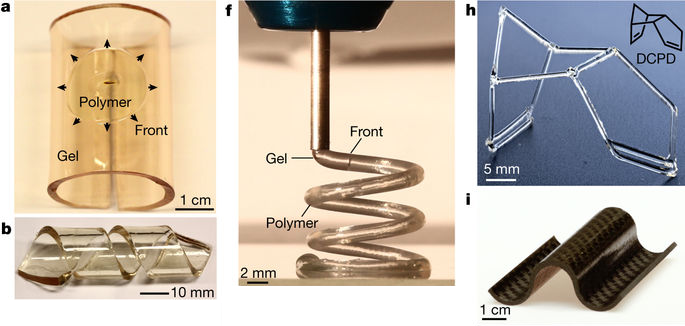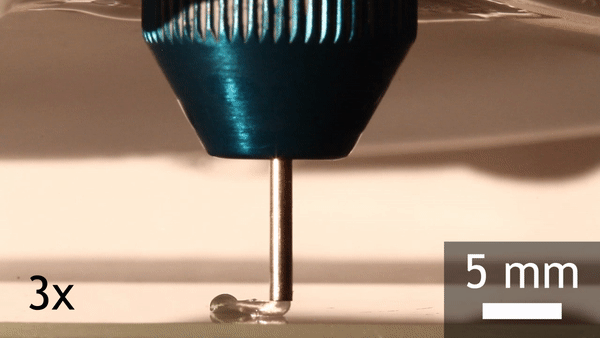Energy efficient production of polymers and composites using frontal polymerization
A curious use of front polymerization for 3D printing was recently published in Nature.

Researchers from the University of Illinois, Urbana-Champaign (University of Illinois, Urbana-Champaign), have developed a new cost-effective method for producing thermosetting polymers and reinforced polymer composite products promising for industrial use.
This method can be used to produce materials such as composite panels for aircraft fuselages, consuming 10 times less energy than modern industrial production technologies. At the same time, new polymers and composites have comparable properties - strength, thermal stability, resistance to bending and chemical resistance.
')
Modern methods of obtaining high-quality thermosetting polymers require the use of an autoclave, which is necessary for the curing of the monomer. The use of the autoclave is quite energy-intensive (about 180 ° C for several hours and reduced pressure), limits the size of the product to the dimensions of the autoclave and requires certain financial investments. According to the researchers, the traditional production of a small section of the composite fuselage of the Boeing 787 fiber-reinforced requires 96,000 kilowatt-hours of electrical energy (~ annual consumption of 9 residential buildings).
To simplify the process, researchers turned to the front polymerization reaction, which is gaining popularity. In the case of frontal polymerization, the monomer and initiator solution is locally heated until the initiator is activated, which will lead to polymerization of the monomer. The heat released from the polymerization reaction will trigger the next activation cycle of the initiator — the polymerization of the monomer until the reagents are exhausted. The name of the process was due to the rapid advance of the line (front) of the reaction through the thickness of the monomer.
UV-triggered frontal polymerization (random youtube example)
The find of researchers was the use of ruthenium-catalyzed metathesis polymerization (FROMP) solutions of dicyclopentadiene (DCPD).

DCPD monomer can polymerize into a thermosetting product in 30 minutes when heated. Further optimization of the conditions allowed us to find alkylphosphite inhibitors and expanded the range of polymerization from 30 minutes to 30 hours. Frontal polymerization of DCPD results in highly efficient crosslinked thermoset polydicyclopentadiene (pDCPD) polymers or polymer composites.

An example of continuous 3D printing and frontal polymerization of a helix from pDCPD.
Researchers are in the process of obtaining a patent and searching for ways to commercialize the development.

Researchers from the University of Illinois, Urbana-Champaign (University of Illinois, Urbana-Champaign), have developed a new cost-effective method for producing thermosetting polymers and reinforced polymer composite products promising for industrial use.
This method can be used to produce materials such as composite panels for aircraft fuselages, consuming 10 times less energy than modern industrial production technologies. At the same time, new polymers and composites have comparable properties - strength, thermal stability, resistance to bending and chemical resistance.
')
Modern methods of obtaining high-quality thermosetting polymers require the use of an autoclave, which is necessary for the curing of the monomer. The use of the autoclave is quite energy-intensive (about 180 ° C for several hours and reduced pressure), limits the size of the product to the dimensions of the autoclave and requires certain financial investments. According to the researchers, the traditional production of a small section of the composite fuselage of the Boeing 787 fiber-reinforced requires 96,000 kilowatt-hours of electrical energy (~ annual consumption of 9 residential buildings).
To simplify the process, researchers turned to the front polymerization reaction, which is gaining popularity. In the case of frontal polymerization, the monomer and initiator solution is locally heated until the initiator is activated, which will lead to polymerization of the monomer. The heat released from the polymerization reaction will trigger the next activation cycle of the initiator — the polymerization of the monomer until the reagents are exhausted. The name of the process was due to the rapid advance of the line (front) of the reaction through the thickness of the monomer.
UV-triggered frontal polymerization (random youtube example)
The find of researchers was the use of ruthenium-catalyzed metathesis polymerization (FROMP) solutions of dicyclopentadiene (DCPD).

DCPD monomer can polymerize into a thermosetting product in 30 minutes when heated. Further optimization of the conditions allowed us to find alkylphosphite inhibitors and expanded the range of polymerization from 30 minutes to 30 hours. Frontal polymerization of DCPD results in highly efficient crosslinked thermoset polydicyclopentadiene (pDCPD) polymers or polymer composites.

An example of continuous 3D printing and frontal polymerization of a helix from pDCPD.
Links to other examples
Nature is in no hurry to keep up with the times, so only links. (Hint, you can use Imagus).
Video 1: pDCPD frontal polymerization of elastic elastic gel rolled into a cylinder.
Video 2: Continuous 3D printing and frontal polymerization of a pDCPD helix.
Video 3: In-plane 12-ply carbon fiber combined heat resistant cable.
A single embedded resistive heating wire for 20 seconds.
Video 4: In-plane frontal curing of a 12-ply carbon fiber joint.
Video 5: Through-thickness frontal curing of a 12-ply carbon fiber made by a surface heater.
Video 1: pDCPD frontal polymerization of elastic elastic gel rolled into a cylinder.
Video 2: Continuous 3D printing and frontal polymerization of a pDCPD helix.
Video 3: In-plane 12-ply carbon fiber combined heat resistant cable.
A single embedded resistive heating wire for 20 seconds.
Video 4: In-plane frontal curing of a 12-ply carbon fiber joint.
Video 5: Through-thickness frontal curing of a 12-ply carbon fiber made by a surface heater.
Researchers are in the process of obtaining a patent and searching for ways to commercialize the development.
Source: https://habr.com/ru/post/371509/
All Articles